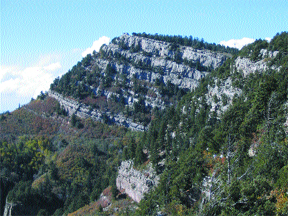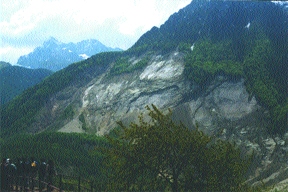Every month, we'd like to feature one of your photos from anywhere in the world and invite other readers to guess where it was taken. Look every month in the print Geotimes for a new photo. Following are clues, answers and winners from past issues.


| Do you have slides and photos you've
collected from field work or vacations? Every month, we'd like to feature one of your photos from anywhere in the world and invite other readers to guess where it was taken. Look every month in the print Geotimes for a new photo. Following are clues, answers and winners from past issues. |
 |
| Send answers for the March 2005 Where on Earth?
contest, which appears in the print magazine, to Geotimes by March
28 (or postmarked by this date). From those answers, Geotimes staff
will draw the names of 10 people who will win Where on Earth? T-shirts.
And from those 10 names, we will draw the names of two people who will win
a Brunton compass.
Click here
to submit a guess for this month's Where on Earth?
contest. Submit
photos for Where on Earth? |

|
Clues: 1. This feature bears a characteristic that John W. Powell recognized in the early 20th century: a gap in the rock record between ancient granite and overlying sandstone. 2. This feature takes its name from a native word for a vibrant-colored fruit. 3. The world’s longest cable tram runs up the side of this mountain to a total elevation higher than 10,000 feet. In the 40 years the tram has been running, it has carried more than 8 million people to the peak and back.the feature and its location.
Name the feature and its location. Scroll down for the answer |
| Answer: Check back next month for the answer and the winners. |

|
Clues: 1. In the 1960s, this landslide raged into an artificial lake behind
a new hydroelectric dam, creating a tidal wave that wiped out several
towns and killed more than 2,000 people. A movie was made about the landslide. 3. The oldest human settlements in this region date to 7000 B.C. Many
different empires have ruled this region at one time or another, leaving
a multicultural environment behind. Name the landslide and location. Scroll down for the answer |
| Answer: The Vajont (or Vaiont) landslide occurred off Mount Toc in the Dolomite Mountains of Northern Italy on Oct. 9, 1963. The mountainside collapsed into the reservoir behind the new Vajont Dam, displacing water that then surged over the dam and flooded villages in the valleys downstream. Photo is courtesy of Matteo Brestuglia. |
January 2005 Winners
Carlos Albrizzio (Encinitas, Calif.)
Anne Argast (Fort Wayne, Ind.)
Daniel Bernoulli (Basel, Switzerland)
Mark Chen (Oklahoma City, Okla.)
Kaushal Desai (Springfield, Ill.)
Gina Iwahashi (Sacramento, Calif.)
Sid Perkins (Washington, D.C.)
William Robinson (Lubbock, Texas)
Mike Tuohy (Buford, Ga.)
Kimo Zaiger (Somis, Calif.)
 |
Geotimes Home | AGI Home | Information Services | Geoscience Education | Public Policy | Programs | Publications | Careers |